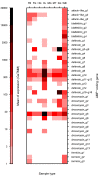Identification of the Gene Repertoire of the IMD Pathway and Expression of Antimicrobial Peptide Genes in Several Tissues and Hemolymph of the Cockroach Blattella germanica
- PMID: 35955579
- PMCID: PMC9369362
- DOI: 10.3390/ijms23158444
Identification of the Gene Repertoire of the IMD Pathway and Expression of Antimicrobial Peptide Genes in Several Tissues and Hemolymph of the Cockroach Blattella germanica
Abstract
Antimicrobial peptide (AMP) genes, triggered by Toll and IMD pathways, are essential components of the innate immune system in the German cockroach Blattella germanica. Besides their role in killing pathogenic bacteria, AMPs could be involved in controlling its symbiotic systems (endosymbiont and microbiota). We found that the IMD pathway was active in the adult female transcriptomes of six tissues (salivary glands, foregut, midgut, hindgut, Malpighian tubules and fat body) and hemolymph. Total expression of AMP genes was high in hemolymph and salivary glands and much lower in the other sample types. The expression of specific AMP genes was very heterogeneous among sample types. Two genes, defensin_g10 and drosomycin_g5, displayed relevant expression in the seven sample types, although higher in hemolymph. Other genes only displayed high expression in one tissue. Almost no expression of attacin-like and blattellicin genes was observed in any sample type, although some of them were among the genes with the highest expression in adult female whole bodies. The expression of AMP genes in salivary glands could help control pathogens ingested with food and even determine gut microbiota composition. The low expression levels in midgut and hindgut are probably related to the presence of beneficial microbiota. Furthermore, a reduction in the expression of AMP genes in fat body could be the way to prevent damage to the population of the endosymbiont Blattabacterium cuenoti within bacteriocytes.
Keywords: Blattella germanica; IMD pathway; antimicrobial peptides (AMPs); innate immune response; symbiosis; transcriptome.
Conflict of interest statement
The authors declare no conflict of interest.
Figures





Similar articles
-
Comparative Transcriptomics of Fat Bodies between Symbiotic and Quasi-Aposymbiotic Adult Females of Blattella germanica with Emphasis on the Metabolic Integration with Its Endosymbiont Blattabacterium and Its Immune System.Int J Mol Sci. 2024 Apr 11;25(8):4228. doi: 10.3390/ijms25084228. Int J Mol Sci. 2024. PMID: 38673813 Free PMC article.
-
Antimicrobial peptide expression in the cockroach gut during enterobacterial infection is specific and influenced by type III secretion.Biol Open. 2022 May 15;11(5):bio059414. doi: 10.1242/bio.059414. Epub 2022 May 25. Biol Open. 2022. PMID: 35611712 Free PMC article.
-
Blattella germanica displays a large arsenal of antimicrobial peptide genes.Sci Rep. 2020 Dec 3;10(1):21058. doi: 10.1038/s41598-020-77982-3. Sci Rep. 2020. PMID: 33273496 Free PMC article.
-
Of Cockroaches and Symbionts: Recent Advances in the Characterization of the Relationship between Blattella germanica and Its Dual Symbiotic System.Life (Basel). 2022 Feb 15;12(2):290. doi: 10.3390/life12020290. Life (Basel). 2022. PMID: 35207577 Free PMC article. Review.
-
A review of the mechanisms and components that determine the transmission efficiency of Tomato yellow leaf curl virus (Geminiviridae; Begomovirus) by its whitefly vector.Virus Res. 2014 Jun 24;186:47-54. doi: 10.1016/j.virusres.2014.01.022. Epub 2014 Feb 5. Virus Res. 2014. PMID: 24508344 Review.
Cited by
-
Unraveling the Role of Antimicrobial Peptides in Insects.Int J Mol Sci. 2023 Mar 17;24(6):5753. doi: 10.3390/ijms24065753. Int J Mol Sci. 2023. PMID: 36982826 Free PMC article. Review.
-
The gut microbiota confers resistance against Salmonella Typhimurium in cockroaches by modulating innate immunity.iScience. 2024 Oct 30;27(12):111293. doi: 10.1016/j.isci.2024.111293. eCollection 2024 Dec 20. iScience. 2024. PMID: 39628558 Free PMC article.
-
Survival of Salmonella Typhimurium in the hemolymph of the German cockroach vector is limited by both humoral immune factors and hemocytes but not by trehalose metabolism.J Med Entomol. 2023 Sep 12;60(5):875-883. doi: 10.1093/jme/tjad076. J Med Entomol. 2023. PMID: 37348971 Free PMC article.
-
Comparative Transcriptomics of Fat Bodies between Symbiotic and Quasi-Aposymbiotic Adult Females of Blattella germanica with Emphasis on the Metabolic Integration with Its Endosymbiont Blattabacterium and Its Immune System.Int J Mol Sci. 2024 Apr 11;25(8):4228. doi: 10.3390/ijms25084228. Int J Mol Sci. 2024. PMID: 38673813 Free PMC article.
References
-
- Bell W.J., Roth L.M., Nalepa C.A. Cockroaches: Ecology, Behavior, and Natural History. Johns Hopkins University Press; Baltimore, MD, USA: 2007.
MeSH terms
Substances
Grants and funding
LinkOut - more resources
Full Text Sources

